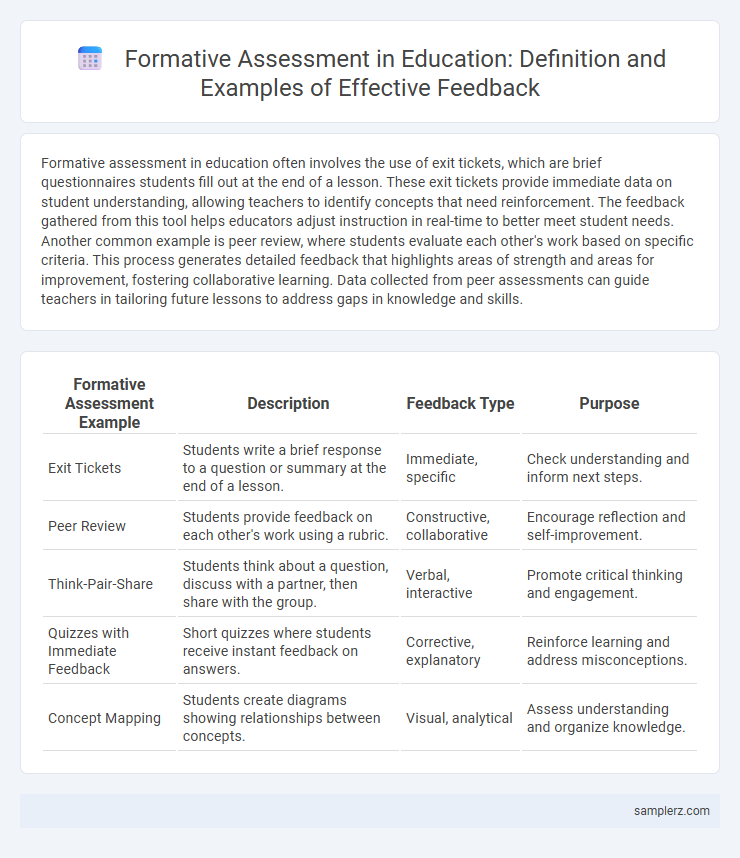Formative assessment in education often involves the use of exit tickets, which are brief questionnaires students fill out at the end of a lesson. These exit tickets provide immediate data on student understanding, allowing teachers to identify concepts that need reinforcement. The feedback gathered from this tool helps educators adjust instruction in real-time to better meet student needs. Another common example is peer review, where students evaluate each other's work based on specific criteria. This process generates detailed feedback that highlights areas of strength and areas for improvement, fostering collaborative learning. Data collected from peer assessments can guide teachers in tailoring future lessons to address gaps in knowledge and skills.
Table of Comparison
| Formative Assessment Example | Description | Feedback Type | Purpose |
|---|---|---|---|
| Exit Tickets | Students write a brief response to a question or summary at the end of a lesson. | Immediate, specific | Check understanding and inform next steps. |
| Peer Review | Students provide feedback on each other's work using a rubric. | Constructive, collaborative | Encourage reflection and self-improvement. |
| Think-Pair-Share | Students think about a question, discuss with a partner, then share with the group. | Verbal, interactive | Promote critical thinking and engagement. |
| Quizzes with Immediate Feedback | Short quizzes where students receive instant feedback on answers. | Corrective, explanatory | Reinforce learning and address misconceptions. |
| Concept Mapping | Students create diagrams showing relationships between concepts. | Visual, analytical | Assess understanding and organize knowledge. |
Understanding Formative Assessment in Education
Formative assessment in education includes techniques such as exit tickets, where students write brief responses to gauge their comprehension of a lesson. Another effective example is peer review, allowing learners to provide constructive feedback to each other, enhancing their critical thinking skills. These strategies help teachers identify learning gaps and tailor instruction to improve student outcomes continuously.
Key Features of Effective Formative Feedback
Effective formative feedback includes clear, specific, and actionable comments that guide students toward improvement by highlighting strengths and identifying areas for growth. Timely feedback allows learners to apply suggestions immediately, enhancing understanding and skill development. Constructive dialogue between teachers and students fosters a supportive learning environment, promoting self-reflection and motivation.
Real-Time Feedback Techniques in the Classroom
Real-time feedback techniques in the classroom include using clickers or interactive polls to gauge student understanding instantly during lessons, enabling immediate correction and clarification. Teachers can also implement live quizzes and digital platforms like Kahoot or Google Forms to provide instant scoring and explanations, fostering active engagement. These formative assessment strategies help educators adjust instruction dynamically to meet students' learning needs effectively.
Peer Assessment as a Formative Feedback Tool
Peer assessment serves as a powerful formative feedback tool by enabling students to evaluate each other's work, promoting critical thinking and self-reflection. This approach encourages collaborative learning and provides diverse perspectives, helping learners identify strengths and areas for improvement. Research shows that peer feedback improves student engagement and enhances understanding of assessment criteria.
Utilizing Exit Tickets for Ongoing Assessment
Exit tickets serve as effective formative assessment tools by allowing educators to gather immediate feedback on student understanding at the end of a lesson. These brief, targeted prompts help identify learning gaps and inform instructional adjustments in real time. Utilizing exit tickets regularly enhances student engagement and promotes continuous improvement in teaching strategies.
Digital Tools for Instant Formative Feedback
Digital tools such as Kahoot!, Google Forms, and Quizlet enable instant formative feedback by allowing educators to create interactive quizzes and surveys that assess student understanding in real-time. These platforms provide immediate, data-driven insights, helping teachers identify learning gaps and adjust instruction promptly. Integrating such digital tools enhances engagement while facilitating continuous feedback cycles critical for personalized learning.
The Role of Self-Assessment in Student Growth
Self-assessment in education empowers students to identify learning gaps and set personalized goals, enhancing metacognitive skills crucial for academic growth. By reflecting on their work, students develop critical thinking and intrinsic motivation, leading to improved performance and deeper understanding. Educators facilitate this process through targeted prompts and rubrics, ensuring feedback is constructive and aligned with learning objectives.
Incorporating Questioning Strategies for Feedback
Incorporating questioning strategies for formative assessment feedback enhances student understanding by prompting critical thinking and self-reflection. Techniques such as open-ended questions, probing inquiries, and thought-provoking prompts encourage learners to analyze their responses and identify areas for improvement. This dynamic interaction supports personalized learning and helps educators tailor instruction based on immediate feedback.
Providing Constructive Comments on Student Work
Providing constructive comments on student work involves detailed, specific feedback that highlights strengths and identifies areas for improvement, promoting deeper understanding and skill development. Effective formative assessment comments focus on clear criteria and actionable suggestions, such as recommending strategies to enhance argument clarity or improve mathematical problem-solving steps. This targeted feedback encourages student reflection and guides ongoing learning progress within the educational process.
Actionable Steps for Teachers to Improve Feedback Practices
Formative assessment examples include using exit tickets to gauge student understanding and guide lesson adjustments, or implementing peer review sessions to foster collaborative learning. Teachers can enhance feedback by providing specific, targeted comments that focus on skills improvement rather than general praise. Incorporating regular, timely feedback loops helps students identify clear, actionable steps for growth and promotes a continuous learning mindset.

example of formative assessment in feedback Infographic
 samplerz.com
samplerz.com